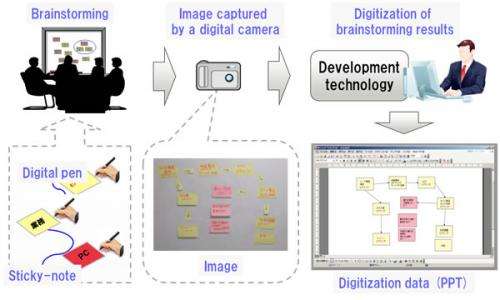Fujitsu Laboratories today announced that it has developed an industry-first technology supporting the digitization of results from sticky-note brainstorming sessions by utilizing a digital pen.
Sticky-note brainstorming is becoming an essential part of business analysis and idea generation, and is widely viewed as a necessary step in concept-building and the exchange of ideas within many enterprises and organizations. Until now, digitally recording the arrangement and content of sticky-notes for sharing and record-keeping had to be done manually, requiring photographs to be taken of groupings, which took up considerable man-hours. Now however, Fujitsu Laboratories has developed a technology that, by utilizing a digital pen in conjunction with proprietary image processing technology, supports the digitization of individual sticky-note placement and contents from captured images of groupings. This new technology will assist in recalling the brainstorming session and simplifying searches at a later date, boosting usefulness of those sessions, while successfully reducing man-hours by more than 80% compared with conventional manual methods.
Fujitsu Laboratories plans to announce details of this technology at the Technical Committee on Pattern Recognition and Media Understanding (PRMU) to be held in Kobe from March 29, 2012.
Sticky-note brainstorming is becoming an essential part of business analysis and idea generation, and is widely viewed as a necessary step in concept-building and the exchange of ideas within many enterprises and organizations. At Fujitsu, employees are conducting sticky-note brainstorming in field innovation activities together with customers in order to analyze their business challenges. However, since the results of brainstorming sessions can only be recorded, saved, and applied by performing concurrent digitizing operations, such as manually converting the handwritten sticky-notes to text, considerable man hours are required; improving the efficiency of these tasks has been difficult.
In the past, converting brainstorming results to an electronic form required photographs to be taken of groups of sticky-notes affixed to a whiteboard or wall, and then manually converting the arrangement and content of those notes into text from the captured images. However, brainstorming is usually conducted in lighted environments, and as such, the photographed notes were often too bright or obscured by shadow, making it difficult to extract data from the notes' surfaces automatically using image processing. In addition, the freeform nature of words written on the notes' surfaces caused difficulties in achieving a high degree of precision, even when applying character recognition for handwriting.
Key Features of the New Technology
1. High-precision note area extraction system
This system automatically extracts sticky-note surface area data from images captured by a digital camera with a high degree of precision. Because the system converts the image to a multi-tiered binary format and hierarchically analyzes the results to locate each sticky-notes' surface area, data can be extracted with high accuracy, regardless of the illumination level.
2. Method for mapping digital pen stroke information with sticky-notes
Since pen stroke information can be recorded using a digital pen, character recognition utilizing that information produces results of a higher precision than traditional handwritten character recognition based on images alone. The system collates image data from the extracted sticky-note surface area and the stroke information from the digital pen. It can also automatically input the results of the handwritten character recognition from the digital pen as text in the corresponding note. This enables highly accurate automatic text input.
All that is required to use this technology is a PC, a digital camera, and a digital pen. It achieves a reduction in man-hours required for digitization by more than 80% compared with conventional manual input. The results of brainstorming sessions can be easily converted to other formats, including PowerPoint or Excel, enabling utilization in a variety of ways, such as looking back to brainstorming processes at a later date and reorganizing brainstorming data.
Source: Fujitsu




















